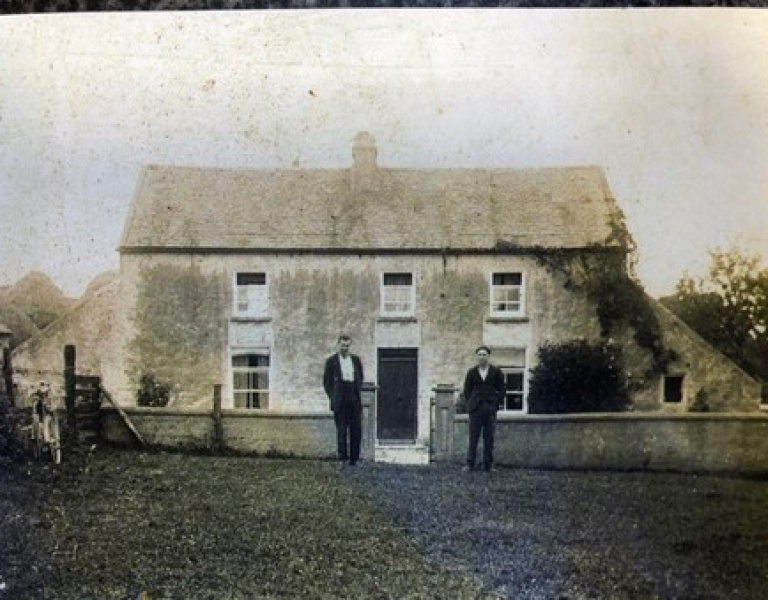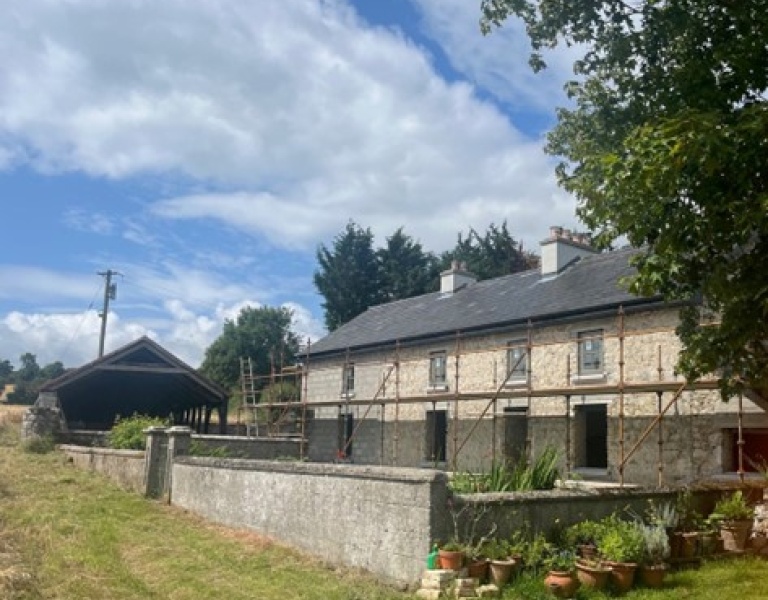Traditional Homes Pilot - Gortavalla Farmhouse
SEAI's Traditional Homes Pilot supports homeowners improving the energy performance of traditionally constructed dwellings while acknowledging their particular conservation needs.
Supporting homeowners, breathing life back into traditional homes
Around 16% of Ireland’s private housing stock, or approximately 270,000 dwellings, predates 1945[i]. These buildings are predominantly of solid masonry, traditional construction, typically using brick, stone or clay with lime-based mortars and renders. They often feature single-glazed timber or metal windows, and timber-framed roofs clad in slate, tiles, copper, lead, or, less commonly, corrugated iron or ‑thatch.[ii]
Recognising the unique challenges these buildings present, the Department of Housing, Local Government & Heritage (DHLGH) published Improving Energy Efficiency in Traditional Buildings: Guidance for Specifiers and Installers (2023). This document outlines best practice for upgrading traditional fabric without compromising heritage value or building performance.
Building on this guidance, the Sustainable Energy Authority of Ireland (SEAI) launched the Traditional Homes Pilot in October 2024. The initiative supports homeowners improving the energy performance of traditionally constructed dwellings while acknowledging their particular conservation needs.
Unlike SEAI’s other home energy grant schemes which support the energy upgrades of existing homes built after 1940, this pilot introduces important flexibilities to allow for a more considered approach to protect the structure of these traditional buildings. These flexibilities include:
- Non-Agrément certified products can be specified and installed where appropriate.
- Relaxed minimum U-value requirements allow solutions that respect the building’s fabric and hygrothermal behaviour.
To ensure the most appropriate energy retrofit solutions are applied, every project must be overseen by a traditional building professional i.e. a registered architect, engineer, or surveyor with recognised conservation accreditation, or proven equivalent experience. This professional is responsible for specifying appropriate materials and methods, and for signing a “Declaration of Works” confirming the works have been installed in accordance with the DHLGH guidance document[iii].
For architects, this pilot represents an exciting opportunity to shape sensitive, technically robust interventions that marry heritage conservation with energy efficiency, setting a precedent for the sustainable future of Ireland’s historic homes. Jacqui Donnelly, Senior Architect national Built heritage Service, DHLGH, welcomed the pilot saying “Our traditional buildings are a valuable and irreplaceable resource. Improving energy efficiency in these buildings is key to meeting our climate targets while providing comfortable, safe and beautiful homes for generations to come. SEAI’s Traditional Homes Pilot is a welcome opportunity for owners to get appropriate advice on suitable and sustainable methods and materials to use in order to achieve the best outcomes from energy upgrading works. The benefits will include reducing the risk of damage to the fabric and character of the building or to the health of its occupants.”
[i] Census 2011
[ii] Department of Housing, Local Government & Heritage (DHLGH) published Improving Energy Efficiency in Traditional Buildings: Guidance for Specifiers and Installers (2023).
[iii] Department of Housing, Local Government & Heritage (DHLGH) published Improving Energy Efficiency in Traditional Buildings: Guidance for Specifiers and Installers (2023).
The following case study highlights one of the first projects coming through the pilot and is a great example of the type of homes the pilot seeks to support:
PROJECT: Gortavalla Farmhouse Renovation & Extension
LOCATION: Gortavalla, Cloughjordan, Co. Tipperary
CLIENT: Clifford and Gillian Guest
ARCHITECT: Caelan Bristow MRIAI, Accredited in Conservation Grade 3
MAIN CONTRACTOR: Sancrest construction Birr Count Offaly
ONE STOP SHOP: Kore Retrofit
Background
Gortavalla farmhouse, constructed approximately two hundred years ago has been owned by the Guest family for six generations. The original structure was a “two up/two down” rubble stone farmhouse, typical of the area. Later extensions were built to the gables and to the rear. Those in the second half of the twentieth century were built in hollow block, without insulation and on minimal raft foundations. The renovation aims to conserve the original building, improve energy efficiency, and replace the extensions with energy-efficient designs with a finished floor area or circa 200m2. The use of natural, breathable, bio-based materials was prioritised, along with maximising natural light and preserving original features where possible.
Retrofit Process
1. Building Fabric
A comprehensive analysis of the existing structure was conducted, including a BER assessment and an engineer’s report. For insulation, conservation principles guided the use of breathable materials. For the stone walls Diasen Diathonite cork/lime breathable insulating plaster was used and supported by the grant scheme. An application of 50mm external and 50mm internal is expected to achieve a U-value of between 0.36 – 0.31 W/m2K. A breathable floor was also specified, but a new concrete slab with 150mm PIR insulation was subsequently chosen due to cost issues and time constraints. New high specification energy-efficient windows have been installed.
2. Building Services and air tightness
The existing heating system (oil boiler and stove back boiler) was replaced with an air-source heat pump system. Underfloor heating was installed for the ground floor, while high-output radiators serve the first floor. The build for the entire house will reach modern air tightness standards and a mechanical ventilation heat recovery system has been installed (Design intent 3m3/m2/hr).
Project Insights
1. Cost of Bio-Based Materials
Bio based materials were the preferred specification for this project however for value engineering purposes the proposed insulated fired clay block construction for the new extension was replaced with a more cost-effective solution using 200mm full-fill bead insulation to achieve the same thermal performance.
2. Foundation Issues
The original stone walls were supported by compacted soil, necessitating underpinning to support the structure during groundworks.
3. Variable Ground Levels
Significant variations in ground floor levels required adjustments to door head and ceiling heights, adding 3.7% to the budget.
4. Unforeseen Problems with Existing Work
The roof which was previously renovated in 2011, was poorly constructed, requiring full replacement which added costs. The foundations of the previous extensions were also inadequate, requiring demolition and rebuilding.
5. Timeline Considerations
The lead time for windows and doors was 9-10 weeks, and drying time for lime plaster was longer than expected, affecting the project schedule.
Current status
The project is underway since January 2025 and is due for completion in December 2025. The roof is installed, insulation and airtightness membranes are in place, and the first fix plumbing, heating, and electrics are complete.
The scheme was a welcome alternative to the other SEAI grant schemes, especially because it recognised the sensitive approach required when working with older buildings. It encourages the use of more appropriate materials for these types of buildings and also ensures professional oversight by requiring the involvement of a conservation professional. It also allows the grant value to be deducted from the final costs of the works meaning our client only had to pay the balance. The oversight by the One Stop Shop adds another level of quality control to the project. Learnings from this first project on the pilot include the requirement for early engagement with the One Stop Shop to ensure the grant requirements are considered and all parties understand the process, including agreeing the financial aspects of the process with the main contractor. We understand a pathway guidance document is currently being prepared by the RIAI and the SEAI to help clarify this process.
Climate Without Compromise
In a climate emergency, we can’t afford to leave any part of our housing stock behind. The SEAI Traditional Homes Pilot aims to ensure Ireland’s architectural past can be part of its sustainable future. It seeks to gain a detailed understanding of the technical aspects, materials, products, and associated costs for the solutions required for traditional homes.
Sensitive to heritage, and grounded in energy efficiency, this pilot aims to show what’s possible when we design for both character and carbon. The hope is that the lessons learned by retrofitters, homeowners and building professionals about materials, methods, and systems, will inform the blueprint for how we retrofit Ireland’s most iconic homes.
If you have any projects, you believe would benefit from the pilot or would be interested in acting as a traditional building professional, we recommend first reaching out to an SEAI registered One Stop Shop.

